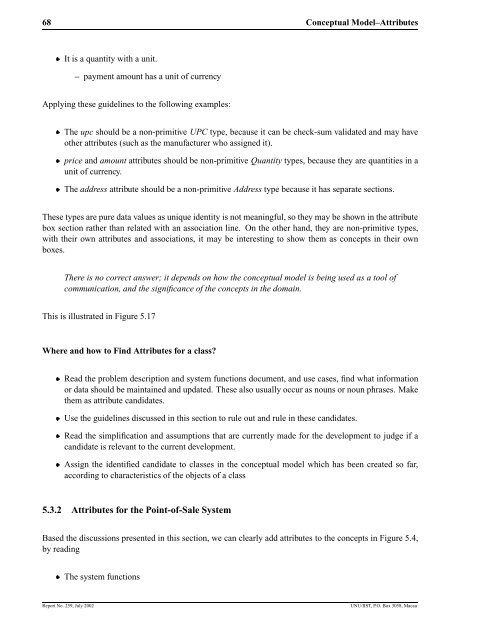Object-Oriented Software Development with UML - UNU-IIST ...
Object-Oriented Software Development with UML - UNU-IIST ...
Object-Oriented Software Development with UML - UNU-IIST ...
You also want an ePaper? Increase the reach of your titles
YUMPU automatically turns print PDFs into web optimized ePapers that Google loves.
68 Conceptual Model–AttributesIt is a quantity <strong>with</strong> a unit.=– payment amount has a unit of currencyApplying these guidelines to the following examples:The upc should be a non-primitive UPC type, because it can be check-sum validated and may have=other attributes (such as the manufacturer who assigned it).unit of currency.=price and amount attributes should be non-primitive Quantity types, because they are quantities in a=The address attribute should be a non-primitive Address type because it has separate sections.These types are pure data values as unique identity is not meaningful, so they may be shown in the attributebox section rather than related <strong>with</strong> an association line. On the other hand, they are non-primitive types,<strong>with</strong> their own attributes and associations, it may be interesting to show them as concepts in their ownboxes.There is no correct answer; it depends on how the conceptual model is being used as a tool ofcommunication, and the significance of the concepts in the domain.This is illustrated in Figure 5.17Where and how to Find Attributes for a class?=Read the problem description and system functions document, and use cases, find what informationor data should be maintained and updated. These also usually occur as nouns or noun phrases. Makethem as attribute candidates.Use the guidelines discussed in this section to rule out and rule in these candidates.=Read the simplification and assumptions that are currently made for the development to judge if a=candidate is relevant to the current development.Assign the identified candidate to classes in the conceptual model which has been created so far,=according to characteristics of the objects of a class5.3.2 Attributes for the Point-of-Sale SystemBased the discussions presented in this section, we can clearly add attributes to the concepts in Figure 5.4,by reading=The system functionsReport No. 259, July 2002<strong>UNU</strong>/<strong>IIST</strong>, P.O. Box 3058, Macau
















